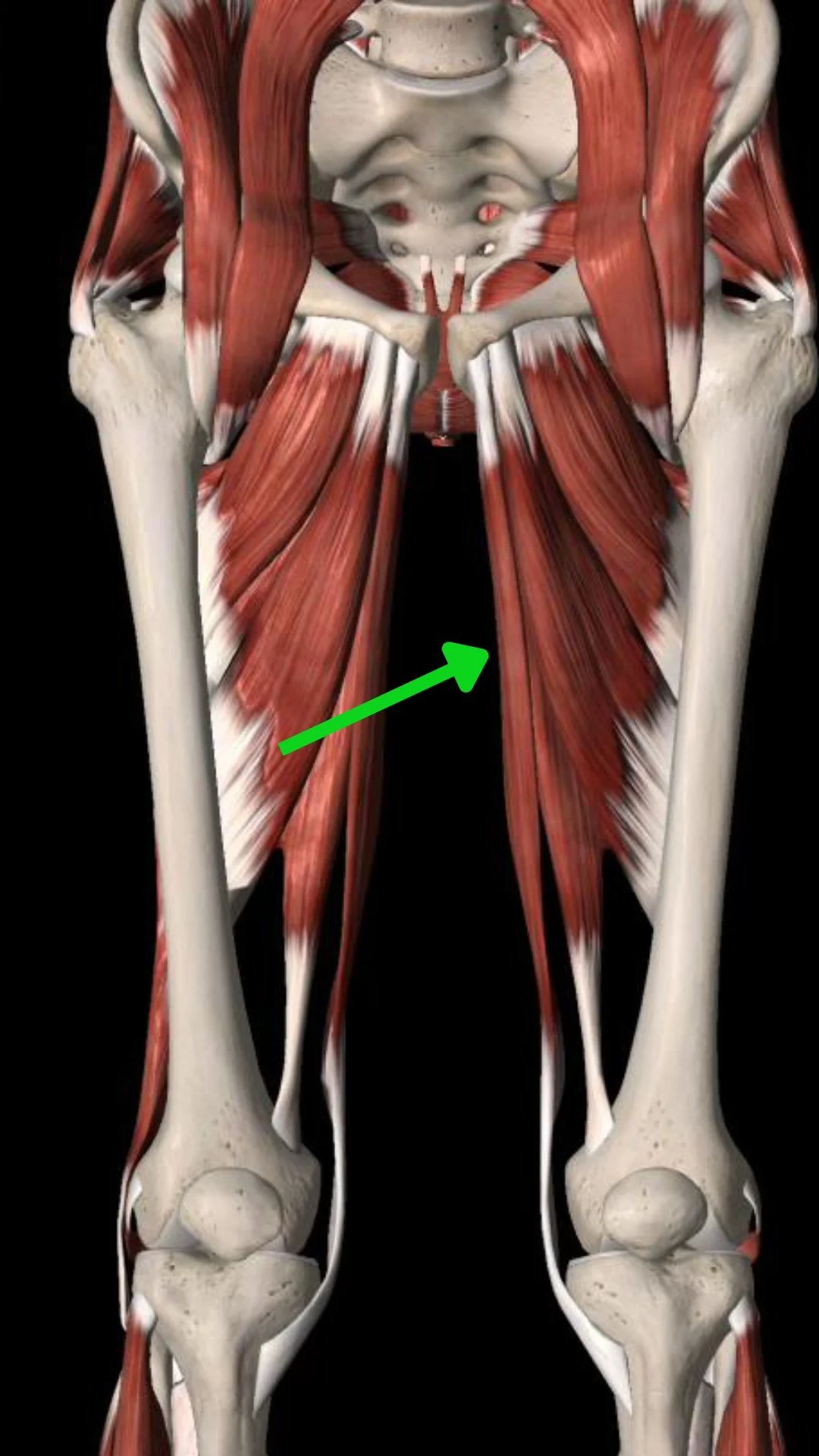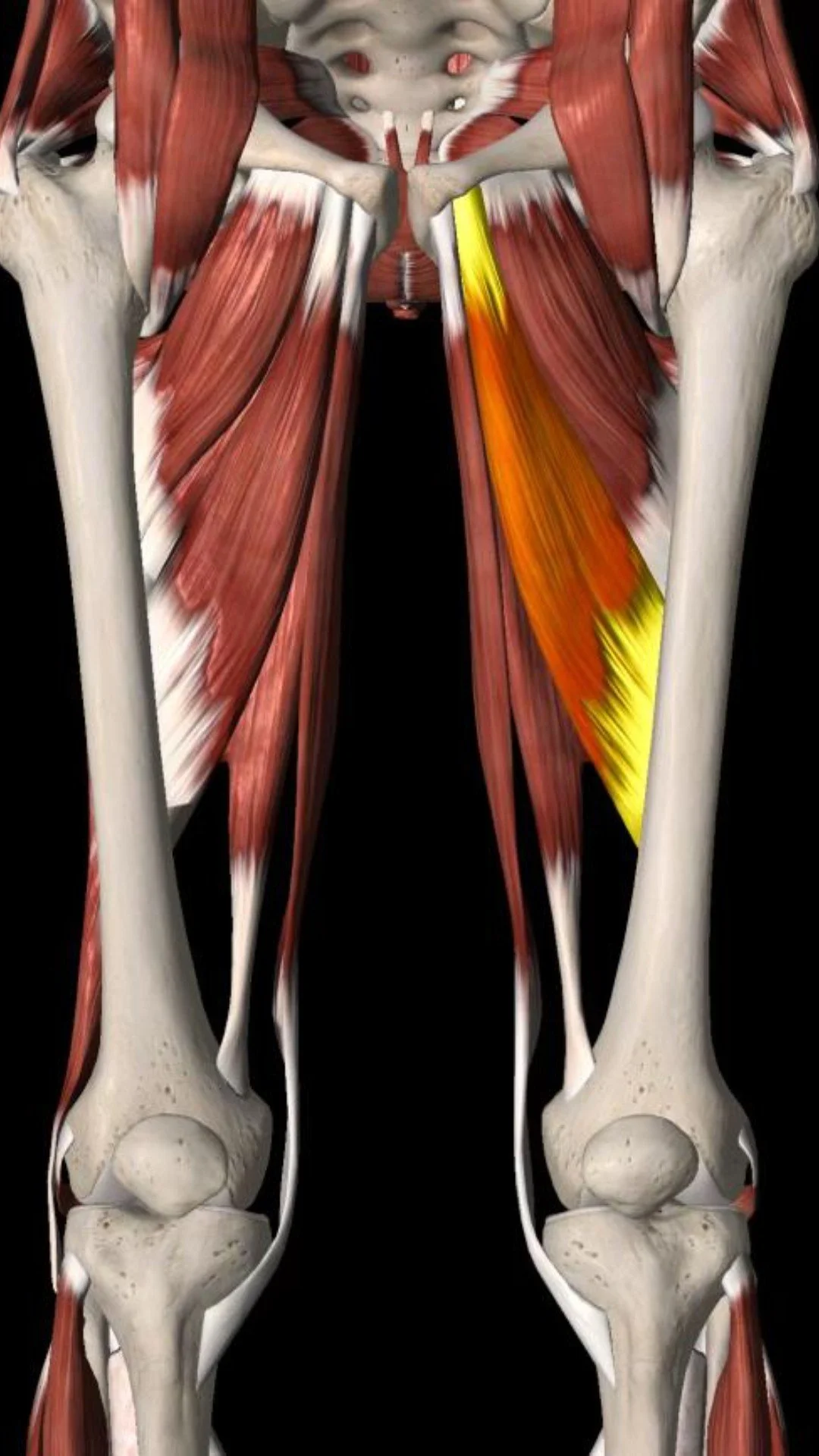Physical Therapy for Hip Adductor Strain
Return to Sport After Adductor Strain
What is an adductor strain?
An adductor strain is an acute injury that occurs to one or more of the adductor muscles on the inside of the thigh. Adductor strains are graded by severity and location. Grade 1 is the most mild version of an adductor muscle strain, and Grade 3 is the most severe (indicating a full tear of the adductor muscle and/or adductor tendon). The adductor longus is the most commonly torn adductor muscle.
Adductor Muscles
Adductor Longus
Adductor strains typically occur in sports such as football, soccer, hockey, and dance. The most common mechanism of injury is when the leg is rapidly moving away from midline, such as can be seen in the kicking and skating motions (think of sudden, explosive changes in direction).
Groin Strain Symptoms
Individuals with groin strains experience symptoms such as groin pain when stretching and contracting the adductor muscle group. In the cases of worse grades of strain, there may also be swelling and/or bruising to the inner thigh region.
Who is at risk to develop a groin strain injury?
Risk factors for groin strains include male sex, previous injury, groin pain in the previous season, hip adductor weakness, and hip abductor weakness. Training error is also a major risk factor, as many athletes rapidly increase their training volume and intensity in the preseason while being underprepared to do so.
The eccentric hip adductor to hip abductor strength ratio is also a risk factor for groin strains. A ratio of 0.8 or less is associated with increased risk of acute adductor strain. In other words, it is key to maintain a fairly even ratio of strength between the hip adductors and abductors.
How do we diagnose a groin strain?
At The Game Plan Physical Therapy, we diagnose a groin strain by performing tests that involve stretching and manual resistance to the adductor muscle group. We also palpate the adductor muscle group to identify where the strain has occurred.
How long does a groin strain take to heal?
Groin strains heal well, as most muscle injuries do. The grade and location of the injury influence healing time frames. Grade 1 groin strains typically take 2-4 weeks to heal. Grade 2 groin strains take 4-8 weeks to heal. And Grade 3 groin strains can take 3-4 months to heal. The closer the injury is to the tendon (or if there is tendinous involvement), the longer the healing time frame. Returning to sport after a groin strain while minimizing risk of re-injury involves a proper rehab protocol (more on that later).
Groin Strain Treatment
Treatment of groin strain should address the modifiable risk factors including:
Poor off season conditioning
Hip muscle weakness
Adductor to abductor muscle strength ratio <80%
Lower abdominal muscle weakness
General lower extremity weakness
Decreased flexibility (although there is weak evidence to suggest that decreased adductor flexibility is associated with increased risk of groin strain)
Decreased hip joint range of motion
Lack of sport-specific training
The treatment techniques we utilize with our clients is primarily exercise-based for this particular pathology. However, we do utilize soft tissue massage techniques to help with pain, bruising and swelling. We also utilize gradual, progressive stretching, and joint mobilization techniques if we identify limitations in hip muscle flexibility and/or hip joint mobility.
The treatment can be broken down into phase of rehab, as can be seen below:
Acute Phase (24-48 hours) & Subacute Phase (2-7 days post-injury):
Primary goals:
Protect the injured structure from further damage
According to this research article, early and repeated application of ice can be used to limit tissue damage in the initial few hours following a muscle injury.
Pain control
Reduce inflammation and edema
Normalize flexibility if limited
Exercises to prevent excessive muscular inhibition
Should provoke minimal or no pain
Light to moderate loads
We want to see clear adductor muscle activation during isometric contractions
Conditioning Phase:
Primary Goals:
Gradual and progressive loading of the adductors
Light (≥ 15-rep maximum) to moderate (10-12-rep maximum) loads while still respecting the healing tissue
Strengthening for hip and pelvic muscles for both sides
Static and dynamic strengthening exercises
Slow concentric, isometric, and eccentric contractions
Balance and coordination exercises (sliding boards, unstable surfaces, wobble boards, upper and lower limb swinging exercises, etc.)
Sport-Specific Exercise Phase:
Primary goals:
Restore muscle/tendon endurance and strength
Restore aerobic and anaerobic capacity
Improve neuromuscular control, balance, and coordination in sport specific movements
Dynamic strengthening exercises are continued from moderate to heavy (8-10-rep maximum) loads
Dynamic exercises of the adductors and abductors with good technique (correcting any compensation strategies)
Slow and heavy concentric, isometric, and eccentric contractions
Slowly build up to faster and faster movements (without changing the resistance)
Exercises that use the stretch-shortening cycle to reintroduce explosive movements such as kicking, sprinting, etc.
Introduce plyometric exercises to restore and optimize hip and knee joint stiffness and sport-specific performance (jumping, hopping, cutting, etc.)
Groin Strain Stretches: What are the best adductor stretches?
Dynamic: Adductor Rock Backs
(short lever and long lever variations)
Static: Frog Stretch
Groin Strain Exercises: What are the best groin strain strengthening exercises?
Adductor Squeeze Isometric
Side-lying Adduction
Sliding Abduction
Copenhagen Planks
Side Planks
Forearm Plank with Abduction
Groin strain exercises to avoid
Early in the rehab process, you’ll want to avoid activities and exercises such as aggressive stretching of the adductors, kicking, skating, lateral lunges, deep lunges, deep squats, sprinting, cutting, and pivoting. These exercises can place too much tension or strain on the adductor muscle while the tissue is healing.
How to prevent groin strains?
The best way to prevent groin strains is to incorporate strengthening of the hip adductors, abductors, and core muscles. These muscles work together to stabilize the hip. They also work together on movement coordination and muscle firing timing. Some of the recommended exercises videos can be referenced above.
In general, programs like these include a few exercises (6-10) that progressively load these muscles, with a focus on time under tension (slow, controlled movements). 2-3 sets of each exercise are performed every other day. We also advise including explosive movement patterns that focus on change of direction to improve muscle timing and rate of force development.
Of note, the Copenhagen adductor exercise has been well studied, and according to the literature, inclusion of this exercise in a strength training program can increase eccentric adductor strength and decrease risk of groin strain injuries.
Returning to sport after an adductor strain
The return to sport phases are broken down into 3 phases (in this order): return to participation, return to sport, and return to performance.
There are some benchmarks that need to be met when returning to participation after an adductor strain. We require our athletes to have no or minimal (0-2/10) pain during or after the following before we clear them for return to sport:
Clinical exam, including adductor palpation, stretching, and adductor squeeze test
Adductor strength training at heavy loads (10-rep maximum)
Sport specific training including maximal actions of running, sprinting, change of direction, skating, and kicking (depending on the sport the athlete is attempting to return to).
We also want to see that our athletes have at least 80-90% of full muscle strength of their adductors (compared to the uninvolved side).
In the return to sport phase, athletes should focus on returning to their specific sport, either individually or with their team. The athlete can start with 30 minutes of training, and will progress towards 90 minutes over a few weeks before a full return to sport against live competition. At this stage, we want the adductor muscle strength at 100% of the uninvolved side.
Return to pre-injury level performance is often not achieved for several months after the initial injury (3-6 months). We recommend continuing with the strength training program 3 days per week until pre-injury performance has been achieved. The athlete can work towards increasing the load to an 8-10 rep max per set for 2-3 sets in this stage. Some recommend continuing a maintenance program with these types of exercises 1x/week.
Closing Remarks
If you are dealing with an adductor strain, or groin pain related to your sport, contact us below to speak with a physical therapist.
Disclaimer: This is not intended to be formal medical advice. Your individual needs should be met by the appropriate health care practitioner. Please consult with a trusted provider.
Dr. Paul Nasri PT, DPT, OCS, COMT
Dr. Vincent Liu PT, DPT
Doctor of Physical Therapy


